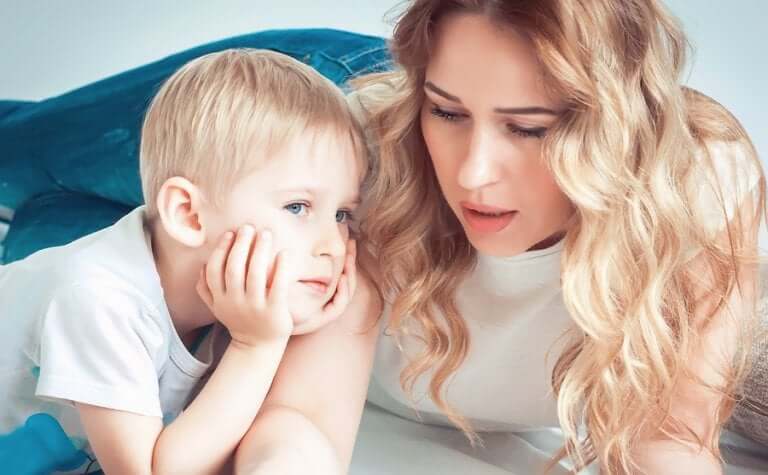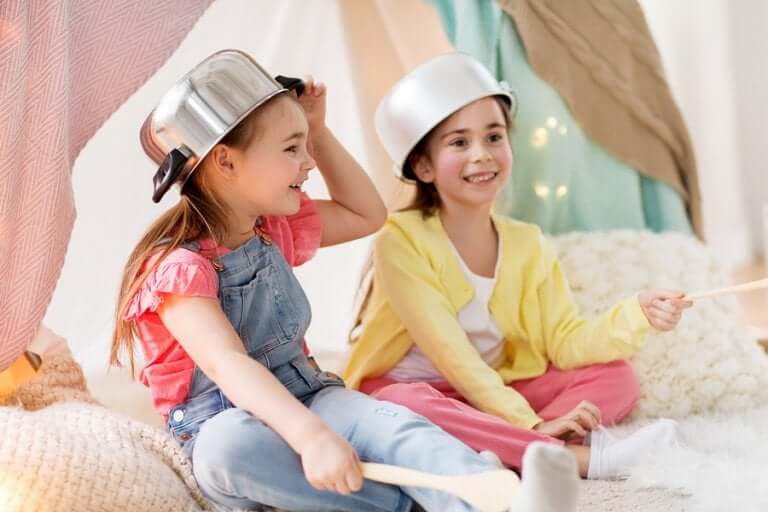4 Ways to Help Children Make Friends

As our children get older, socialization becomes more and more important. Friends give them security, foster their self-esteem and become a reference point for them to develop the social skills that will serve them throughout the rest of their lives.
Helping children make friends requires a little observation and a lot of tact on your part.
Why is it so important to help children make friends?
It’s true that up to 3 years of age, interaction with other children is not completely essential. However, between the ages of 4 and 11, integration into a social group becomes increasingly important, and becomes crucial on reaching adolescence.
Friendships promote a child’s self-esteem, thanks to the fact that it’s through relationships with others that they begin to acquire self-knowledge. This implies being aware of their abilities, limitations, and the image that others have of them, etc.
When they learn to communicate with their peers, to establish ties and to cooperate, then they’re starting to develop their capacity for empathy. Undoubtedly, this is a very important quality for their emotional development.
Relationships with people other than family members help children to mature. They force them to develop skills and strategies, seek solutions and, invariably, this expands their vision of the world.
However, what for some is very easy and natural, for others seems to be an impossible mission. If your child belongs to the group that has a hard time relating to others, then we’re here to tell you that there are techniques you can use to help children make friends.
How to help children make friends
1. Don’t let your emotions get in the way
We hate seeing our children end up as victims in their relationships with others, and we start to get involved…for better or for worse. Even though you’re hurting for them, it’s possible that, even though they’ve been rejected, your child hasn’t actually experienced any negative emotions.
However, if you get involved then you can actually cause more problems than were there in the first place. If you say to them “Poor thing, you must feel bad”, or if you tell them that the child who rejected them is a “bad” person, then the message you’re giving them isn’t a very constructive one.

Rejection may be an issue that affects you, but don’t you think your child should also learn to say “no” to others? In this way they can experience what it’s like to say “no”, and what it’s like to be rejected by someone else. The truth is that we don’t always want to interact with those around us.
On the other hand, on many occasions, the experiences that our children experience often remind us of things that happened to us too. They remind us of situations that were traumatic for us in the past and that we believe must also be traumatic for them.
However, you must remember that your child will react differently, and it’s a very positive thing to give him the opportunity to do so.
2. Time to investigate
Once you’ve separated yourself from your emotions, you should really investigate how your child feels about it. Try a relaxed chat, maybe during a walk in the park or sitting down for a snack. Try to find somewhere you can share for a while without pressure or interruption.
Be tactful, don’t ask point-blank questions; he may feel intimidated or even think that something bad is happening. The first thing you need to know is whether their lack of friends bothers them, and what emotion it creates inside them: anger, sadness, frustration, indifference, among others.
Once you find this out, it’ll be easier for you to help them. It’s vital to know what it is that’s preventing them from relating to others. It may be because they’re shy, they may be more advanced than their peers, or they may prefer spending time with adults rather than children.
They may also be hooked on games that isolate them from those around them. This happens a lot with video games, of course.
Another possibility here is that your child may be a victim of bullying. You should be aware that this could be the case with your child and you’ll need to observe them to see if they’re being bullied, and then decide how you should act.
“When children learn to communicate with their peers, to establish ties and to cooperate, then they’re starting to develop their capacity for empathy.”
3. Taking action
Once you have enough information to know what’s happening and why your child has trouble relating to others, then you can get down to work with some simple strategies that are usually very helpful in helping children to make friends.
Here are two examples:
Common interests: Suppose you have a daughter who loves superheroes and you see that a child in her class often wears a Thor t-shirt. Maybe you could draw her attention to that girl to see whether they may have things in common. “Isn’t that child in your class? It looks like she’s as into superheroes as you are.”

A safe environment: Use places where children feel comfortable, such as their home. Suggest to them that they invite some children home to show them their toys. At the same time, you could prepare some nice snacks for them all to enjoy. They can then practice their social skills in a safe, controlled environment.
4. Open their horizons
Make sure your child gets involved in activities outside of school. She may like to play a sport or even learn to play a musical instrument.
Sharing specific hobbies and interests outside of the school environment is a very positive step for children. In this way, they’ll have already overcome the first obstacle, which is to find something in common with other people.
As our children get older, socialization becomes more and more important. Friends give them security, foster their self-esteem and become a reference point for them to develop the social skills that will serve them throughout the rest of their lives.
Helping children make friends requires a little observation and a lot of tact on your part.
Why is it so important to help children make friends?
It’s true that up to 3 years of age, interaction with other children is not completely essential. However, between the ages of 4 and 11, integration into a social group becomes increasingly important, and becomes crucial on reaching adolescence.
Friendships promote a child’s self-esteem, thanks to the fact that it’s through relationships with others that they begin to acquire self-knowledge. This implies being aware of their abilities, limitations, and the image that others have of them, etc.
When they learn to communicate with their peers, to establish ties and to cooperate, then they’re starting to develop their capacity for empathy. Undoubtedly, this is a very important quality for their emotional development.
Relationships with people other than family members help children to mature. They force them to develop skills and strategies, seek solutions and, invariably, this expands their vision of the world.
However, what for some is very easy and natural, for others seems to be an impossible mission. If your child belongs to the group that has a hard time relating to others, then we’re here to tell you that there are techniques you can use to help children make friends.
How to help children make friends
1. Don’t let your emotions get in the way
We hate seeing our children end up as victims in their relationships with others, and we start to get involved…for better or for worse. Even though you’re hurting for them, it’s possible that, even though they’ve been rejected, your child hasn’t actually experienced any negative emotions.
However, if you get involved then you can actually cause more problems than were there in the first place. If you say to them “Poor thing, you must feel bad”, or if you tell them that the child who rejected them is a “bad” person, then the message you’re giving them isn’t a very constructive one.

Rejection may be an issue that affects you, but don’t you think your child should also learn to say “no” to others? In this way they can experience what it’s like to say “no”, and what it’s like to be rejected by someone else. The truth is that we don’t always want to interact with those around us.
On the other hand, on many occasions, the experiences that our children experience often remind us of things that happened to us too. They remind us of situations that were traumatic for us in the past and that we believe must also be traumatic for them.
However, you must remember that your child will react differently, and it’s a very positive thing to give him the opportunity to do so.
2. Time to investigate
Once you’ve separated yourself from your emotions, you should really investigate how your child feels about it. Try a relaxed chat, maybe during a walk in the park or sitting down for a snack. Try to find somewhere you can share for a while without pressure or interruption.
Be tactful, don’t ask point-blank questions; he may feel intimidated or even think that something bad is happening. The first thing you need to know is whether their lack of friends bothers them, and what emotion it creates inside them: anger, sadness, frustration, indifference, among others.
Once you find this out, it’ll be easier for you to help them. It’s vital to know what it is that’s preventing them from relating to others. It may be because they’re shy, they may be more advanced than their peers, or they may prefer spending time with adults rather than children.
They may also be hooked on games that isolate them from those around them. This happens a lot with video games, of course.
Another possibility here is that your child may be a victim of bullying. You should be aware that this could be the case with your child and you’ll need to observe them to see if they’re being bullied, and then decide how you should act.
“When children learn to communicate with their peers, to establish ties and to cooperate, then they’re starting to develop their capacity for empathy.”
3. Taking action
Once you have enough information to know what’s happening and why your child has trouble relating to others, then you can get down to work with some simple strategies that are usually very helpful in helping children to make friends.
Here are two examples:
Common interests: Suppose you have a daughter who loves superheroes and you see that a child in her class often wears a Thor t-shirt. Maybe you could draw her attention to that girl to see whether they may have things in common. “Isn’t that child in your class? It looks like she’s as into superheroes as you are.”

A safe environment: Use places where children feel comfortable, such as their home. Suggest to them that they invite some children home to show them their toys. At the same time, you could prepare some nice snacks for them all to enjoy. They can then practice their social skills in a safe, controlled environment.
4. Open their horizons
Make sure your child gets involved in activities outside of school. She may like to play a sport or even learn to play a musical instrument.
Sharing specific hobbies and interests outside of the school environment is a very positive step for children. In this way, they’ll have already overcome the first obstacle, which is to find something in common with other people.
All cited sources were thoroughly reviewed by our team to ensure their quality, reliability, currency, and validity. The bibliography of this article was considered reliable and of academic or scientific accuracy.
- Bagwell, C.L., & Schmidt, M.E. (2011). Friendships in childhood and adolescence. Nueva York: The Guilford Press.
- Coplan, R.J, & Arbeau, K.A. (2009). Peer Interactions and Play in Early Childhood. Enn K.H. Rubin, W. Bukowski, & B. Laursen (Eds.), Handbook of peer interactions, relationships, and groups (pp. 143-161). Nueva York: The Guilford Press.
- Gifford-Smith, M.E. & Brownell, C.A. (2003). Childhood peer relationships: Social acceptance, friendships and peer networks. Journal of School Psychology, 41, 235-284.
- Schneider, B.H. (2012). Los niños a quienes les cuesta hacer amigos. Conferencia impartida en el Ciclo de Conferencias “Los Lunes en Familia” organizado por el Máster Universitario en Intervención y Mediación Familiar. Universidad Jaume I.
This text is provided for informational purposes only and does not replace consultation with a professional. If in doubt, consult your specialist.








